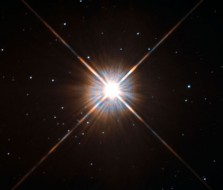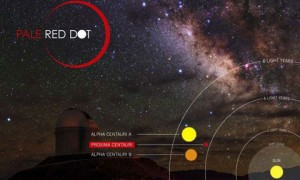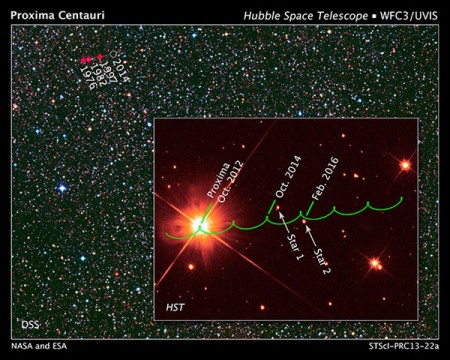The Pale Red Dot Initiative has begun its search for exoplanets orbiting the nearest star to Earth besides the Sun.

ESA / Hubble & NASA
Does the nearest star to our solar system host worlds of its own? 2016 could be the year we find out, as the nearby red dwarf star Proxima Centauri gets scrutinized by astronomers in unprecedented detail using a variety of search methods.
One of the most exciting is the Pale Red Dot initiative. Led by the European Southern Observatory (ESO) scientists, Pale Red Dot is a public campaign to examine Proxima Centauri for exoplanets using the radial velocity method, which looks to tease out the signal of an orbiting planet tugging on its host star. 51 Pegasi – the first exoplanet discovered orbiting a Sun-like star in 1995 – was discovered using this method, and hundreds of discoveries that followed.
"Pale Red Dot"

The Pale Red Dot project started on January 18th and will observe Proxima Centauri every clear night until April 1st, when the analysis phase begins. Pale Red Dot will utilize the High Accuracy Radial velocity Planet Searcher (HARPS) detector coupled to the ESO's 3.6-meter telescope based in Chile to carry out observations. Telescopes around the world participating in the Las Cumbres Observatory Global Telescope Network (LCOGT) and the Burst Optical Observer and Transient Exploring System (BOOTES) will back up HARPS spectra with brightness observations.
Though closeby at only 4.2 light-years away, Proxima Centauri is a tempestuous flare star, which makes a search for a planet’s tell-tale tug a challenge. In the past, untangling the signal from the magnetic activity of such an active star has proven problematic. “This is a hot topic and a matter of intense debate within the community, how to distinguish signals caused by magnetic activity from those of the planets,” says Christina Rodriguez-López (Instituto de Astrofisica de Andalucia/CSIC). “With the best spectrographs, such as HARPS, we are reaching amazing levels of precision in the data.”

ESO / A. Santerne
Astronomers will use HARPS to push the traditional 1-meter-per-second (m/s) regime to its lower limit. That is, current instruments can see a star move by a couple m/s but not much less, so they would miss small and/or faraway planets ¾ an Earth-size planet orbiting its parent star at the same distance Earth orbits the Sun would tug 10 times more gently. Previous searches have ruled out Jupiter-size planets around Proxima Centauri in orbits shorter than 12 years.
“With the integration time we have, we are working at the 'usual' 1 m/s precision per epoch,” says Guillem Anglada (Queen Mary University, UK). “This is a feat by itself thanks to the excellent performance and long term maintenance of the HARPS spectrograph.”
The public can follow the Pale Red Dot campaign on the project’s website, which will host weekly updates from researchers, or readers can follow the Twitter hashtag #PaleRedDot. The campaign takes its name from the famous 'Pale Blue Dot' image, conceived of by the late Carl Sagan and taken of our planet in 1990 by the outbound Voyager 1 spacecraft.
Searches Galore
Other searches for possible planets around Proxima Centauri get underway this year as well.
“It seems that suddenly, Proxima has fallen in the spotlight,” says Anglada. “We are talking about three top techniques scheduled in the same year: high-precision Doppler, transit photometry, and microlensing.”
The Hubble Space Telescope will take advantage of Proxima Centauri’s passage in front of a background star to hunt for possible microlensing events, small spikes in brightness that an Earth-size planet orbiting the red dwarf star could produce as it magnifies the background star’s light.
The orbiting Canadian observatory named MOST (Micro-variability & Oscillations of STars) has also scrutinized Proxima Centauri in the past for exoplanet transits, which would produce a dip in the star’s brightness. The satellite recently completed observing runs 10 and 30 days in length, but hasn’t yet found any signs of intervening planets dimming the star’s light. In theory, the European Space Agency's Gaia mission, as well as the future crop of space telescopes including James Webb Space Telescope and the Transiting Exoplanet Survey Satellite (TESS), could also detect worlds orbiting Proxima Centauri.
Probing in Proximity
If the hype and subsequent controversy following a 2012 announcement of Alpha Centauri Bb, the possible exoplanet orbiting Proxima Centauri’s brighter companion, is any indication, the discovery of a planet around Proxima Centauri could be a historic event.

NASA / ESA / STScl / AURA / UKSTU / AAO
Discovered in 1915 by astronomer Robert Innes, Proxima Centauri has a visual magnitude of +11 and a high proper motion of 3.85 arc seconds per year. Proxima is located in the southern hemisphere constellation of Centaurus, and its common proper motion and location just two degrees from Alpha Centauri led to the suspicion that the stars are very probably gravitationally bound. If so, Proxima orbits the Alpha Centauri A-B pair once every half a million years or so.
Proxima Centauri will make its closest approach to our solar system, passing just 3 light-years away, in about 27,000 years before it begins to recede again. The star Ross 248 claims Proxima’s current title as closest star about 33,000 years from now.
Just 12% the mass of our Sun, red dwarfs like Proxima Centauri are by far the most pervasive types of stars in the universe. If a planet were discovered, it would give astronomers a chance to scrutinize it up close. Though any worlds orbiting in the star’s close-in habitable zone would be routinely subjected to harsh, surface-sterilizing flares, such a miserly star has a life span measured in trillions of years, older than the present age of the universe. This span of time is long enough to get some interesting chemistry started ¾ and perhaps even life.
 4
4









Comments
Anthony Barreiro
January 26, 2016 at 4:13 pm
Thanks for this interesting report. I have a couple of questions --
The fifth paragraph contains this sentence: "That is, current instruments can see a star move by a couple m/s but not much less, so they would miss small and/or faraway planets ¾ an Earth-size planet orbiting its parent star at the same distance Earth orbits the Sun would tug 10 times more gently." I think the 3/4 is a typesetting error and should be a dash. Assuming this is correct, an Earth-sized planet orbiting its parent star at the same distance Earth orbits the Sun would tug 10 times more gently than what?
We would only be able to see planets transiting in front of Proxima Centauri if the planets' orbits cross in front of the star as seen from Earth. Do we know how Proxima Cen's equatorial plane is oriented toward us? Would that information give us any clue as to the likelihood of observable planetary transits?
You must be logged in to post a comment.
Monica Young
January 27, 2016 at 12:19 pm
Hey Anthony, thanks for the catch - I fixed the typesetting error and made the comparison to the 1 m/s limit clearer. About the equatorial plane, I'm not sure scientists know the answer to that yet. But since this experiment is searching for radial velocity tugs rather than transits, they'll still be able to see the stellar wobbles even if the planet's orbital plane isn't aligned with Earth's line of sight.
You must be logged in to post a comment.
Anthony Barreiro
January 29, 2016 at 9:01 pm
Monica, I don't see any change in the article text.
In addition to the radial velocity measurements, the article also says that MOST will be looking for planetary transits.
In any event, it will be very cool if we find planets around Proxima Centauri.
You must be logged in to post a comment.
Monica Young
February 1, 2016 at 11:50 am
That's the downside to page caching 🙂 - try a hard-refresh to see changes.
I suppose the MOST team is trying their luck? I haven't found any sources that give the plane of any putative planets, but maybe they know something I don't...
You must be logged in to post a comment.
You must be logged in to post a comment.